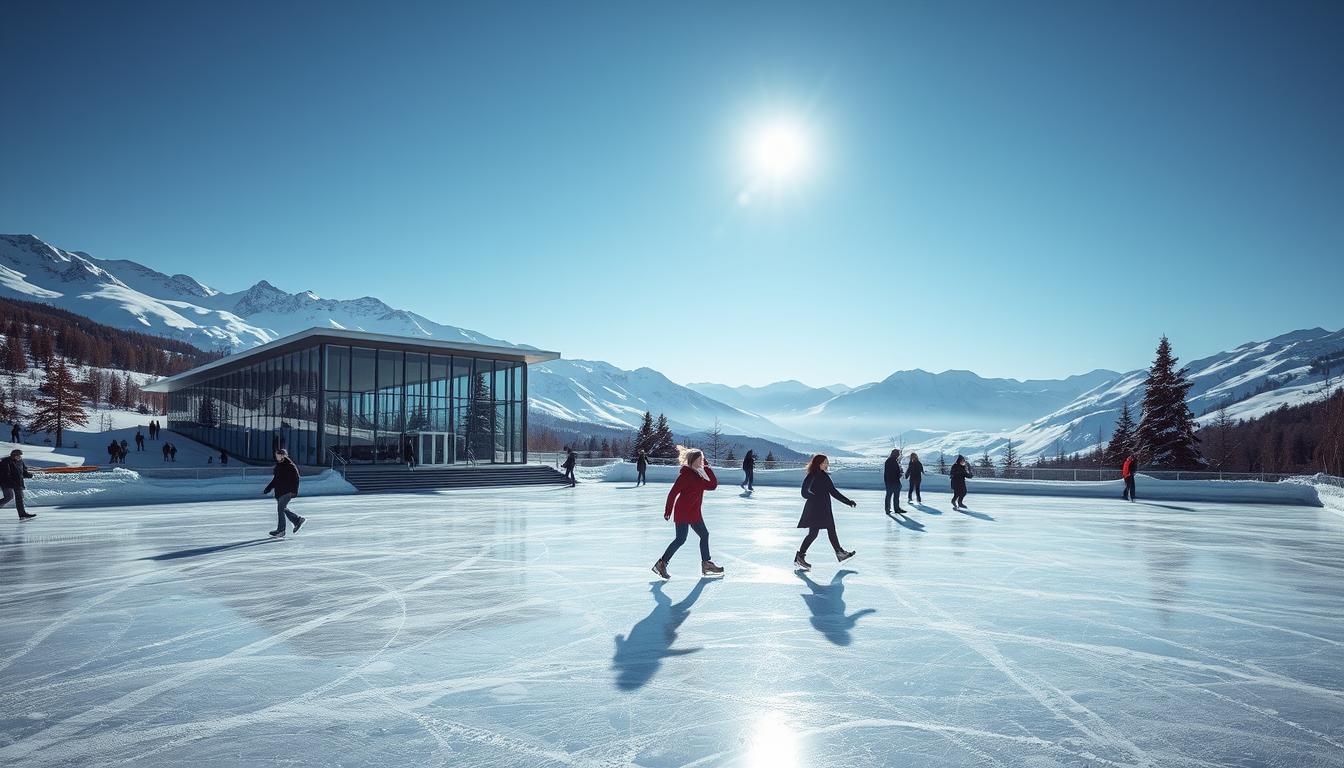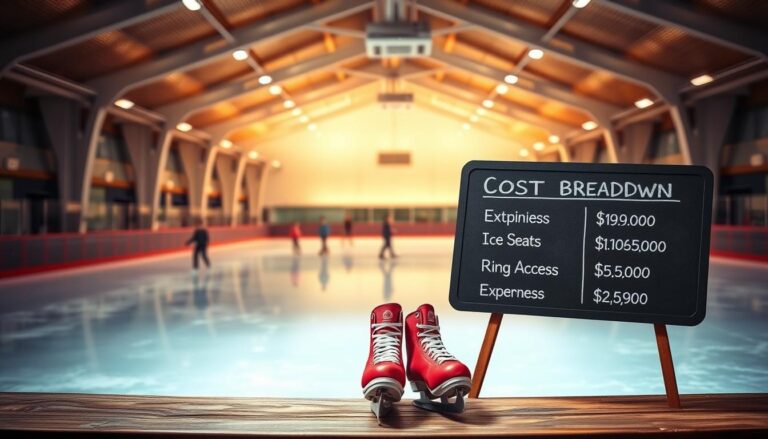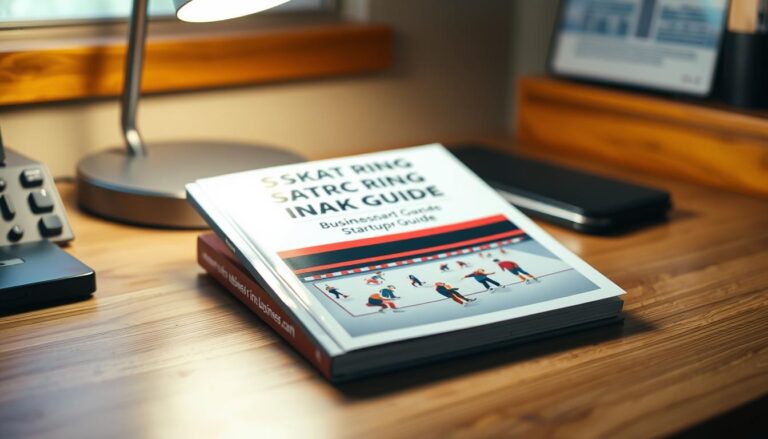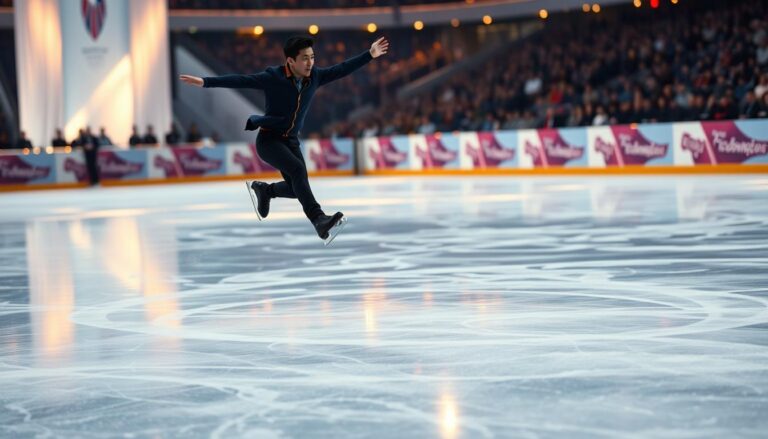Glice Skating: Everything You Need to Know
Imagine turning any flat area into a skating paradise. Welcome to the world of glice skating. This new technology lets you skate on any flat surface, indoors or outdoors. It’s perfect for those who love skating, whether for fun or to practice sports.
Glice skating is more than just a trend. It’s a high-tech way to skate on a fake ice surface. These special panels make skating feel just like the real thing. You can glide, turn, and move freely.
Skaters of all levels are loving glice skating. You can skate indoors or outdoors, anytime you want. No more worrying about the weather or where you can skate.
Glice skating is super flexible. You can put it in gyms, schools, or even your home. Imagine skating in your garage or a community center in the summer. It’s all thanks to this amazing technology.
This guide will show you everything about glice skating. You’ll learn about its tech, benefits, and more. It’s a whole new world of skating, without limits.
Ready to start your glice skating adventure? It doesn’t matter if you’re new or experienced. This journey is full of surprises and new possibilities. Let’s explore together.
What Is Glice Skating
Glice skating is a new way to enjoy winter sports. It lets you skate almost anywhere, unlike ice skating. This is because it uses special synthetic ice technology.
It’s perfect for those who love to skate all year. The technology makes it feel like real ice, thanks to advanced synthetic materials.
Understanding Synthetic Ice Technology
Synthetic ice surfaces are made from special high-density polyethylene panels. They are designed to feel like real ice. This lets skaters move smoothly and naturally.
- Self-lubricating materials that reduce friction
- Interlocking panel systems for seamless surface coverage
- Durability that withstands repeated skating
Key Components of Glice Surfaces
The secret to glice skating is its surface. It’s made with advanced polymers. These panels:
- Minimize friction during skating
- Provide consistent glide performance
- Resist wear and tear
Environmental Impact and Sustainability
Glice skating is an eco-friendly alternative to ice rinks. It doesn’t need constant refrigeration. This cuts down on energy use and carbon emissions.
Skaters can enjoy their sport while helping the planet. This makes glice skating great for those who care about the environment.
The History and Evolution of Glice Skating
Glice skating started as a new idea in synthetic ice tech. Inventors and sports fans wanted a skating experience that could go beyond traditional ice rinks.
At first, people tried to make a smooth, real skating surface for all seasons and places. They tested many materials and tech to get a surface like natural ice.
- 1960s: Initial synthetic ice prototypes developed
- 1980s: First commercial synthetic ice surfaces introduced
- 2000s: Advanced polymer technologies revolutionize glice skating surfaces
The history of glice skating shows big steps in engineering and materials. Companies worked hard to make surfaces that feel like real ice but don’t need it.
Important moments in glice skating tech include:
- Development of low-friction polymers
- Improved surface manufacturing techniques
- Enhanced durability and performance characteristics
Now, glice skating surfaces perform amazingly. Skaters can enjoy their sport in many places. From indoor gyms to outdoor spots, glice skating has changed how we skate.
Today, glice skating keeps getting better. Scientists are always working to make skating even more real and green for fans everywhere.
Benefits of Glice Skating for Fitness and Recreation
Glice skating is a fun way to stay fit and healthy. It’s great for anyone who loves to move and have fun. It’s good for your body and mind.
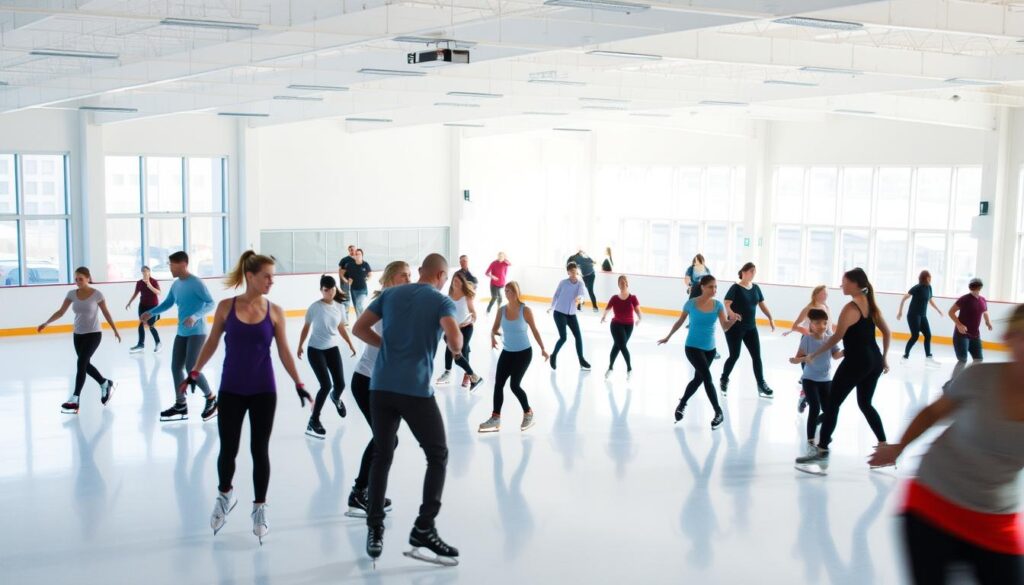
Exploring glice skating opens up a new way to care for your health. It’s a fun activity that offers many benefits.
Physical Health Advantages
Glice skating makes your workouts more exciting. It works your whole body, improving your health.
- Burns up to 500 calories per hour
- Strengthens core muscle groups
- Improves balance and coordination
- Enhances lower body strength
Mental Health Benefits
Glice skating is also good for your mind. It helps you relax and feel happier.
| Mental Health Benefit | Impact |
|---|---|
| Stress Reduction | Releases endorphins, lowers cortisol levels |
| Cognitive Function | Improves focus, spatial awareness |
| Emotional Well-being | Increases self-confidence, reduces anxiety |
Social Aspects of Glice Skating
Glice skating is more than just a workout. It’s a way to meet new people. Joining groups or taking lessons can connect you with others.
- Join local skating clubs
- Participate in group lessons
- Attend community skating events
- Make new friends with shared interests
Ready to transform your fitness journey? Glice skating awaits, promising a fun, engaging path to holistic wellness!
Essential Equipment for Glice Skating
Getting ready for glice skating is more than just excitement. The right gear can make you go from beginner to pro. It’s important to know what you need for synthetic ice.
First, understand that glice skating is different. It needs special gear for the best performance and to last long.
Key Glice Skating Equipment Recommendations
- Specialized Glice Skates with Synthetic Ice Blades
- Protective Gear for Safety
- Maintenance Tools
- Comfort Accessories
Skate Selection Guide
| Equipment Type | Key Features | Price Range |
|---|---|---|
| Glice Skates | Synthetic Ice-Specific Blades | $150-$350 |
| Protective Helmet | Impact-Resistant Design | $50-$120 |
| Blade Maintenance Kit | Specialized Sharpening Tools | $30-$80 |
Pro Tip: Choose high-quality glice skating gear that fits your skill level. It should be comfortable and protect you well.
Essential Protective Gear
- Helmet with proper certification
- Wrist guards
- Knee and elbow pads
- Padded shorts for additional protection
Your glice skating gear is an investment in your safety and skill. Focus on quality, fit, and design for synthetic ice to enjoy your skating fully.
Proper Glice Skating Techniques for Beginners
Starting on a glice surface can be thrilling yet scary. Learning glice skating takes time, effort, and the right steps. This guide will help beginners gain confidence and skill on synthetic ice. It will cover the key movements to turn you from a beginner to a skilled glice skater.
Finding Your Balance
Getting a good stance is key to starting well in glice skating. For beginners, finding balance is essential. Here’s how to start:
- Keep your feet shoulder-width apart
- Bend your knees a bit
- Spread your weight evenly
- Keep your posture straight
Mastering Movement
Learning basic movements is vital for beginners in glice skating. The synthetic surface makes gliding different from ice skating. Focus on:
- Start by pushing off with one foot
- Slide smoothly
- Control your speed
- Try gentle turns
Essential Stopping Techniques
Staying safe is important when you’re learning glice skating. Knowing how to stop well prevents falls and boosts confidence. Try these basic stopping methods:
- Snow Plow Stop: Turn your feet inward to make friction
- Heel Stop: Slow down with the back of your blade
- Keep your center of gravity low
Every pro glice skater was once a beginner. With regular practice and patience, you’ll move smoothly and confidently on synthetic ice.
Advanced Glice Skating Moves and Skills
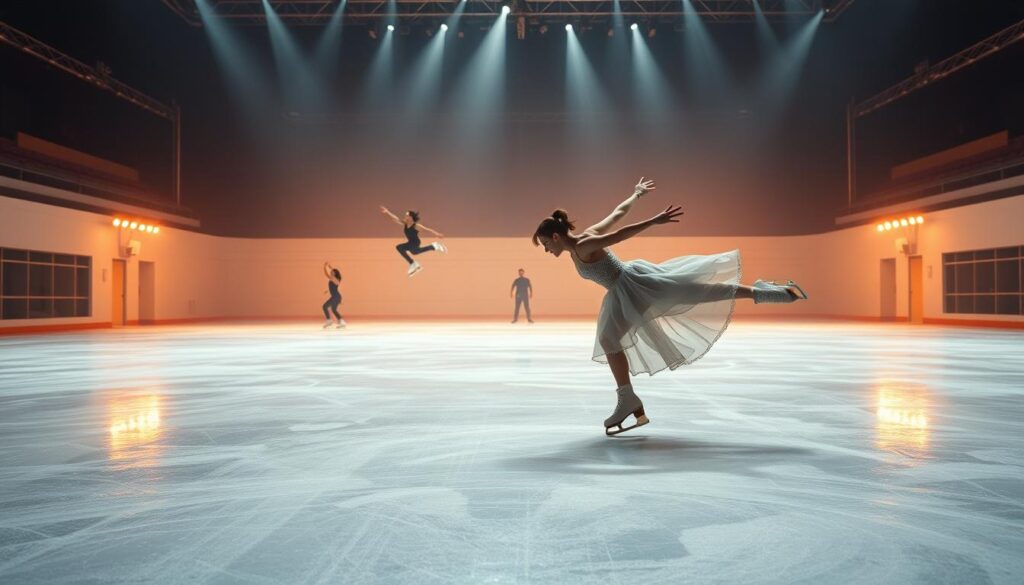
Are you ready to take your glice skating to the next level? Advanced skaters know that mastering complex moves takes precision, practice, and strategic skill development. Glice skating offers exciting possibilities for those who dare to push their limits.
Professional glice skating combines technical skill with creative expression. Skaters can enhance their performance by mastering specific advanced moves. These moves challenge balance and control.
- Crossover techniques for seamless directional changes
- Advanced edge work and footwork sequences
- Spin variations unique to glice surfaces
- Complex jumping techniques
It’s important to understand the differences between traditional ice and glice surfaces. The synthetic surface needs subtle adjustments in weight distribution and blade engagement.
| Advanced Move | Difficulty Level | Key Technique |
|---|---|---|
| Double Spin | Intermediate | Controlled center point rotation |
| Crossover Transition | Advanced | Precise edge control |
| Complex Footwork | Expert | Rhythm and balance synchronization |
Pro tip: Practice each advanced glice skating technique slowly before attempting full-speed execution. Muscle memory and controlled movements are key to mastering complex skills.
Professional skaters suggest consistent training and gradual progression. Breaking down complex moves into smaller parts helps in skill development. It also reduces the risk of injury.
Safety Guidelines and Precautions
Glice skating safety is all about being prepared and aware. It doesn’t matter if you’re new or have been skating for years. Knowing the safety rules is key to having fun without risks.
Protective Gear Requirements
Wearing the right gear is the first step in glice skating safety. You’ll need:
- Helmet (critical for head protection)
- Wrist guards to prevent fractures
- Knee and elbow pads
- Padded skating shorts for additional protection
Common Safety Hazards
Glice skating comes with its own set of challenges. You need to watch out for:
- Unexpected surface slipperiness
- Uneven synthetic ice patches
- Crowded skating areas
- Improper skating technique
Emergency Procedures
It’s important to know what to do in case of an accident. Always stay calm and assess the situation quickly. If someone falls:
- Check for immediate injuries
- Move to a safe area off the skating surface
- Seek assistance from facility staff
- Apply basic first aid if necessary
By following these tips, you can enjoy glice skating safely. Safety is not about being scared. It’s about being smart and confident on the ice.
Comparing Glice Skating vs Traditional Ice Skating
The debate between glice skating and traditional ice skating is fascinating. Both offer unique experiences for skaters of all levels.
Glice skating is a new option compared to ice skating. It has a synthetic surface that provides benefits not found in ice rinks. Skaters enjoy a smooth glide without the temperature and maintenance issues of ice.
Key Differences in Surface Characteristics
- Surface Texture: Glice surfaces offer a more predictable glide compared to traditional ice
- Temperature independence – glice skating works in various environmental conditions
- Lower maintenance requirements for glice surfaces
Comparing performance, glice skating stands out. Traditional ice needs precise temperature control and constant resurfacing. Glice skating offers a more stable environment.
| Feature | Glice Skating | Traditional Ice Skating |
|---|---|---|
| Temperature Dependency | Low | High |
| Maintenance Cost | Lower | Higher |
| Environmental Impact | More Sustainable | Energy Intensive |
Skaters looking into glice skating will find it accessible and versatile. It’s great for both beginners and experienced skaters. The synthetic surface offers a unique experience that challenges traditional ice skating.
Maintaining Your Glice Skating Equipment
Glice skating equipment is a big investment in your skating journey. Keeping it well-maintained ensures it works its best and lasts longer. Knowing how to care for your skates and protective gear is key to a great skating experience.
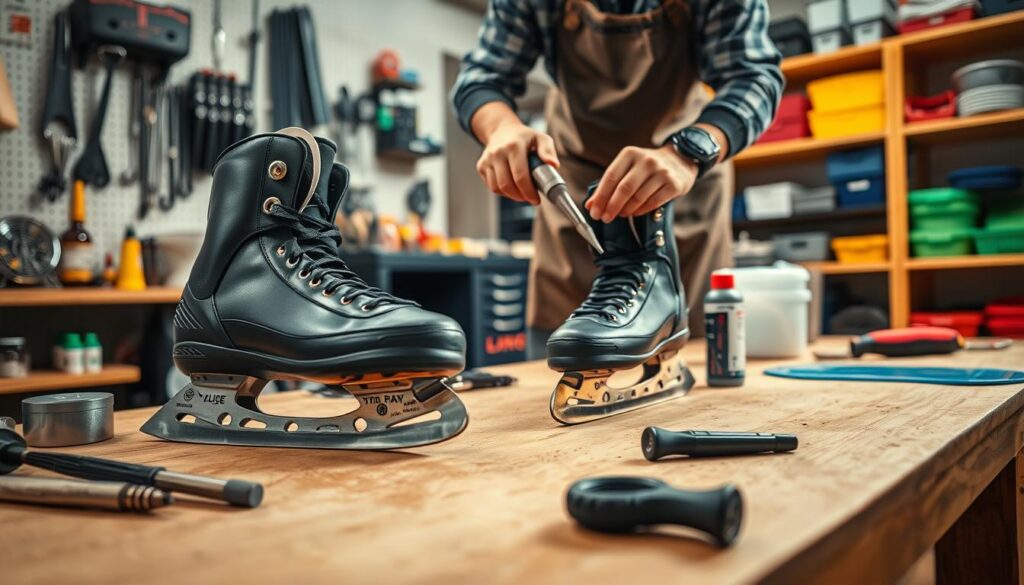
Looking after your glice skating equipment is more than just cleaning. It’s about keeping your gear in top shape through smart maintenance.
Skate Care and Storage Essentials
Start by storing and handling your gear wisely. Here are some tips to keep your equipment in great condition:
- Always dry skates thoroughly after each use
- Store in a cool, dry environment away from direct sunlight
- Use protective blade covers to prevent damage
- Avoid storing skates in damp or humid areas
Blade Maintenance Pro Tips
Blade care is key for top glice skating performance. Precision maintenance helps your equipment last longer:
- Inspect blades regularly for signs of wear
- Clean blades after each skating session
- Use specialized glice skating blade sharpening techniques
- Replace blades when significant wear is detected
Professional skaters suggest a detailed maintenance plan. It protects your investment and keeps you performing well on synthetic ice.
| Maintenance Task | Frequency | Purpose |
|---|---|---|
| Blade Cleaning | After Each Use | Remove debris and prevent rust |
| Blade Sharpening | Every 20-30 Hours | Maintain optimal gliding performance |
| Full Equipment Inspection | Monthly | Check for wear and possible issues |
By following these maintenance tips, you’ll get the most out of your glice skating equipment. Enjoy many smooth and fun skating sessions.
Popular Glice Skating Venues and Facilities
Glice skating has changed how we enjoy winter sports. It brings new skating fun to places we didn’t expect. These synthetic ice surfaces make skating better, welcoming all skill levels.
In the United States, top glice skating spots offer fun for everyone. You can skate indoors or outdoors, showing how versatile synthetic ice is.
- Indoor Entertainment Complexes
- Shopping Mall Skating Areas
- Community Recreation Centers
- Private Training Facilities
- Resort and Hotel Skating Attractions
At glice skating venues, you’ll find amazing features. The synthetic ice is consistent and easy to use, unlike traditional ice.
| Venue Type | Location Characteristics | Skating Experience |
|---|---|---|
| Indoor Complexes | Climate-controlled environments | Year-round skating |
| Outdoor Recreational Areas | Open-air settings | Natural environment skating |
| Community Centers | Accessible local facilities | Affordable skating options |
Professional glice skating places use top-notch synthetic ice. It gives near-ice performance. You get great traction, smooth gliding, and less resistance. It’s perfect for all skaters.
If you want to try glice skating, look up local spots. Check what they offer and get ready for a fun skating adventure that goes beyond traditional winter sports.
Training Programs and Coaching Options
Learning glice skating techniques needs a good plan and expert help. Whether you’re new or getting better, picking the right training is key. It can really help you improve fast. Let’s look at the best ways to boost your glice skating skills.
Group Lessons Structure
Group lessons are a fun way to learn glice skating. They offer many benefits:
- Affordable skill development
- Social learning experience
- Standardized technique instruction
- Peer motivation and support
Private Coaching Benefits
Private coaching is great for those who want one-on-one help. It has special perks:
- Customized skill assessment
- Individual technique refinement
- Accelerated learning pace
- Focused problem-solving
Skill Development Path
| Skill Level | Focus Areas | Recommended Training |
|---|---|---|
| Beginner | Balance, Basic Movements | Group Lessons, Fundamental Techniques |
| Intermediate | Advanced Techniques, Confidence | Mixed Group/Private Coaching |
| Advanced | Complex Maneuvers, Performance | Specialized Private Coaching |
Choosing the right training depends on your goals, how you learn, and how much you’re willing to put in. Invest in quality instruction to transform your glice skating techniques and reach your full synthetic ice skating ability.
Competitive Glice Skating Opportunities
Glice skating competitions have changed the game in winter sports. They give athletes a chance to show off their skills in a new way. Skaters of all levels can compete on synthetic ice surfaces.
These competitions cover many areas, making them challenging and exciting. They draw both new and experienced skaters. Everyone wants to try their hand on this advanced surface.
- Local Tournament Circuits
- Regional Championship Events
- National Glice Skating Competitions
- International Synthetic Ice Championships
Skaters in these competitions face special judging rules. These rules are made for synthetic ice. Skaters need to adjust their moves to perform well on this surface.
| Competition Level | Skill Requirements | Average Participation |
|---|---|---|
| Beginner | Basic Skating Techniques | 50-100 Participants |
| Intermediate | Advanced Skating Skills | 30-75 Participants |
| Professional | Elite Skating Proficiency | 15-40 Participants |
The U.S. Glice Skating Association works hard to make competitions fair and fun. They set rules to ensure everyone has a great time.
If you love skating, these competitions are for you. They’re a thrilling way to test your skills and show off your talent on a new surface.
Cost Considerations and Budget Planning
Starting with glice skating doesn’t have to be expensive. With smart budgeting, you can enjoy this sport without worrying about money. Knowing the costs for equipment and where to skate is key for both newbies and fans.
Equipment Investment Breakdown
Investing in glice skating gear is a smart move for your athletic path. Costs can change based on your skill and dedication. Here’s a detailed look at what you might spend:
- Entry-level glice skates: $100 – $250
- Professional-grade skates: $300 – $600
- Protective gear (helmet, pads): $50 – $150
- Specialized glice skating clothing: $75 – $200
Facility Fees and Membership Options
Looking into glice skating spots means knowing about different prices. Many places offer flexible membership plans to fit various budgets and commitments.
| Membership Type | Monthly Cost | Features |
|---|---|---|
| Drop-in Session | $15 – $25 | Single visit, no commitment |
| Basic Monthly | $50 – $80 | Unlimited weekday sessions |
| Premium Annual | $500 – $800 | All-access, equipment discounts |
To save money, consider these tips:
- Look for used glice skating gear
- Take advantage of seasonal deals
- Join group lessons for lower prices
- Check for discounts for students or seniors
Pro tip: Always compare prices and read the fine print before committing to any membership or equipment purchase.
Common Mistakes to Avoid in Glice Skating
Glice skating for beginners can be tough. Knowing common mistakes helps you learn the right way and stay safe. Whether you’re new or want to get better, avoiding these mistakes will make you more confident.
Now, let’s look at the most common errors that can affect your safety and skill:
- Incorrect Posture: Many beginners lean too far back or forward, disrupting balance and control
- Neglecting proper warm-up exercises that prepare muscles for skating
- Wearing improper or ill-fitting skating equipment
- Failing to maintain blade edges and skating surface
- Overconfidence leading to risky maneuvers beyond skill level
The biggest mistake beginners make is ignoring basic technique. The right stance is key. Keep a slight bend in your knees, stay centered, and keep your arms relaxed. This stance helps you stay stable and move smoothly on synthetic ice.
Staying safe means always learning and being aware. Skaters suggest:
- Taking introductory lessons from certified instructors
- Practicing basic skills before attempting advanced techniques
- Using protective gear, including helmets and padding
- Understanding your personal skill limitations
Every pro started as a beginner. By learning from these tips, you’ll turn mistakes into valuable lessons on your glice skating path.
Seasonal Considerations for Glice Skating
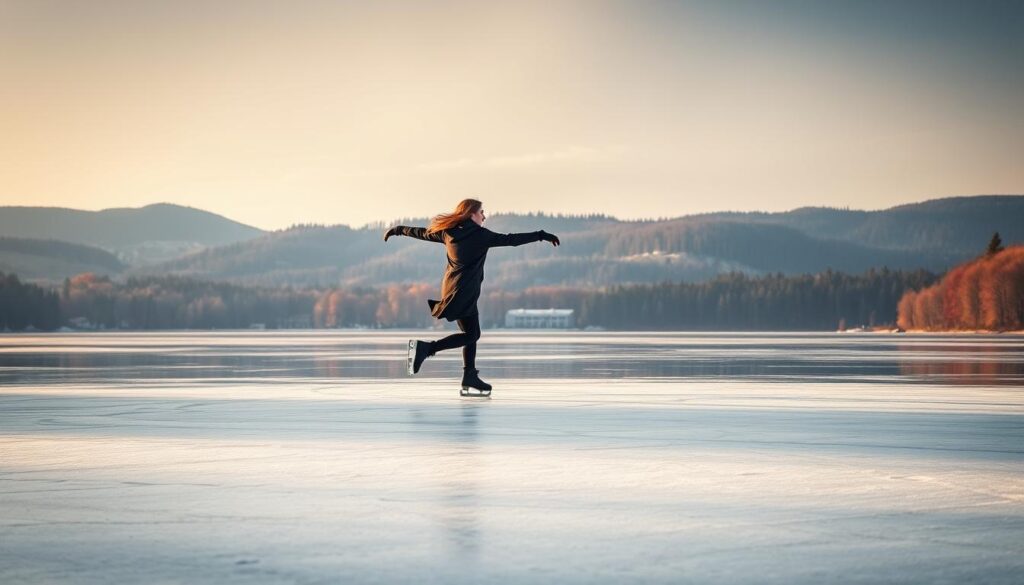
Glice skating changes the game for ice skating fans. It lets them skate all year, not just in winter. This means you can enjoy skating whenever you want, not just when it’s cold.
Every season offers something special for glice skating. It’s a chance for skaters of all levels to have fun. Here are some things to think about for each season:
- Summer Skating: Stay cool in indoor glice rinks
- Autumn Adaptations: Skate outside in the fresh air
- Winter Training: Improve your skills on synthetic ice
- Spring Skill Development: Take part in special workshops
Seasons change how you skate and what gear you need. Think about the weather and how it makes you feel. This helps you get the most out of your skating.
Knowing how seasons affect synthetic ice is key. Keep your gear in good shape, wear the right clothes, and adjust your moves. This way, you’ll skate great all year long.
- Change your skate blade care with the weather
- Choose clothes that keep you comfortable
- Adjust your skating for different surfaces
Glice skating is for everyone, no matter your skill level. It lets you skate all year, not just when it’s cold. It’s a chance to enjoy this fun sport whenever you like.
Conclusion
Glice skating is a world where new ideas meet fun activities. It offers more than just moving around. It changes lives for athletes and fans.
It boosts physical health and mental well-being. This unique skating style helps people grow and have fun.
Skaters of all levels find something special in glice skating. It’s great for a workout, a challenge, or just for fun. Thanks to new tech, it’s more real and fun than ever.
It’s easy to start, with lots of chances to learn and grow. Your glice skating adventure is waiting to begin.
Start your journey with excitement and the right gear. Learn from experts and enjoy every moment. Glice skating offers fun, fitness, and endless chances to explore.
